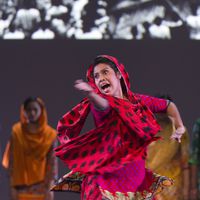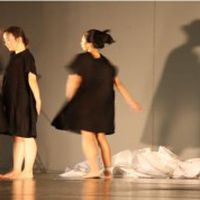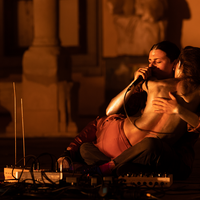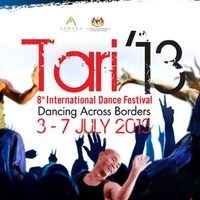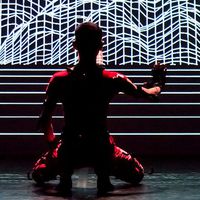Dancing in the Graey: A Festival of Asian Dance in Singapore
 [caption id="attachment_7483" align="alignright" width="290" caption="Credits - Substation"]
[caption id="attachment_7483" align="alignright" width="290" caption="Credits - Substation"]The Graey Festival, staged in Singapore in November at the Substation, had its 3rd edition this year in 2010. The festival originally began as a study of Indian contemporary dance presented to new audiences in Singapore. In its first two editions, in 2007 and 2008, the festival stuck to this edict. In 2010 however, the Graey Festival expanded to include performances from various South East Asian countries including Thailand, Singapore and Indonesia.
What is the Graey Festival?
In 2010 there were two main pillars which drove the programming of the Graey Festival: firstly to foster a new generation of contemporary choreographers and dancers and secondly to examine contemporary dance as it is practiced in parts of South and South East Asia. With this in mind, contemporary dancers were invited to Singapore for week of open rehearsals followed by three nights of performances. In the open rehearsals the public – and, more prominently, students – could come to observe and, to a certain extent, be involved in the shaping of the contemporary dance pieces. The artists invited were: from Singapore Noor Effendy Ibrahim, Elizabeth DeRosa, Raka Maitra, Scarlet Yu Mei Wah, Philip Tan, Yvonne Ng (Singapore/Canada), Zul Mahmod; from Thailand the Pichet Klunchun Company (dancers Julaluck Eakwattanapun & Sunon Wachirawarakarn); from India Tripura Kashyap, Navtej Singh Johar; and from Indonesia Eko Supriyanto.
The idea behind the open rehearsals was for mature contemporary dancers to cut open the process of choreographing a contemporary dance piece and thereby demystifying the process for emerging artists. By seeing the process Raka Maitra (the co-founder and Artistic Director of the festival) believes that you can better understand the reasons behind the final result. This is something she experienced personally in her own artistic development. Dance is such a physical art form, and sometimes you learn the most out of the classroom, by becoming immersed in the process of creation. By watching choreographers cultivate their pieces, Raka hoped the students could gain an insight into the construction of choreographic pieces.
In addition to nurturing emerging choreographers, the festival also explored the idea of what is contemporary dance. In her own development, Raka recalls taking master-classes in what was considered contemporary dance. These master-classes had limited value for her – the movement was very different to her own classical Indian dance training which left her feeling disconnected from the language of this contemporary dance. These experiences evoked questions about what contemporary dance is for her, coming from an Asian dance tradition and training. She felt the need to explore a new language of contemporary dance that did not have its roots in Western dance traditions.
The 2010 edition of the Graey Festival highlighted this exploration of what is contemporary performance throughout its programme. The performers, coming from India, Indonesia, Singapore and India, combined distinct cultural tones to a variety of degrees within their performances. While the Pichet Klunchun Company used traditional Thai music and based their performance in traditional dance movement, Scarlet Yu Mei Wah from Singapore experimented with lights and immersive sound (from artist Phillip Tan) to create a dramatic landscape that had a distinctly chaotic texture. These variations, incorporating distinct cultural qualities, created a dynamic programme which presented diverse aesthetics under the umbrella of contemporary dance. The diverse contemporary practice represented in the festival helped to broaden understandings of what is contemporary dance and clearly articulated distinct languages through which contemporary Asian dance can be communicated.
What role does improvisation play in contemporary dance?
During the open rehearsals, performances and post-performance dialogue, several topics were raised in relation to contemporary dance and its creative process. One of these topics was the role of improvisation. The spontaneity of choreography and creation was revealed in the open rehearsal process. One example of this would be one of the performances of Eko Supriyanto. In the rehearsals, while playing around, he created a piece that was then shown in the performance a few nights later. This piece was light-hearted and whimsical but with an intense undercurrent that provoked questions around identity and cultural hybridity. Using a Javanese mask with popular music, he held the audience spellbound, communicating a complex range of themes with very subtle movements.
This element of improvisation came across in several of the performances, ranging from the free-flowing improvisation of Navtej Singh Johar and Zul Mahmod to the structured improvisation of Yvonne Ng. The structure of the festival also emphasised the role of improvisation in the process of creation, by opening up the rehearsal spaces. It was noted in the post-performance discussions that every day in life we are all improvising, and contemporary dance is simply mirroring this confusion.
What are the challenges of talking across cultures?
Given the melting pot of cultures that were brought together for this festival, the challenges of communicating across cultures were inevitably raised. For the performances there was conspicuously little information provided about the artists and their work. Considering that the performances involved creations from diverse countries and cultures, this was perhaps a brave decision. As these performances developed from distinct traditional backgrounds with diverse symbolism and history, the lack of contextual information could well lead to misunderstandings about the performance. When asked about this, Raka firmly replied that it is not necessary to understand everything and in fact this not-quite-understanding was part of the charm of the performances. The performances, given the maturity of the dancers, effectively conveyed meaning and emotions without the need to have all the secrets unlocked. As stated in the forum at the conclusion of the performances, there is confusion and misunderstandings every day in our lives, why not reflect this in contemporary dance? And we do not need to come from different cultures in order to misunderstand one another. It is rather through dance that we can communicate without words and without barriers of language. In this, the Graey Festival is a celebration of how this cross-cultural communication can be at its most effective.
Where to from here?
When asked about next years’ programme, Raka is hesitant. She does not necessarily see this as a typical yearly or biennial festival structure, one which should be repeated in the same format. This concern for reinvention can be seen in the way the festival has developed over the years. As an audience member, I wait eagerly for another festival such as this that offers a platform for exchange and experimentation within contemporary Asian dance.
For more information about the festival visit: http://graeyfest.com/
Claire Wilson is Project Officer for the Cultural Exchange at the Asia-Europe Foundation
Similar content
deadline
31 Jul 2021
22 Jul 2010
By Kerrine Goh
09 Oct 2023
from - to
03 Jul 2013 - 07 Jul 2013
posted on
21 Feb 2020


